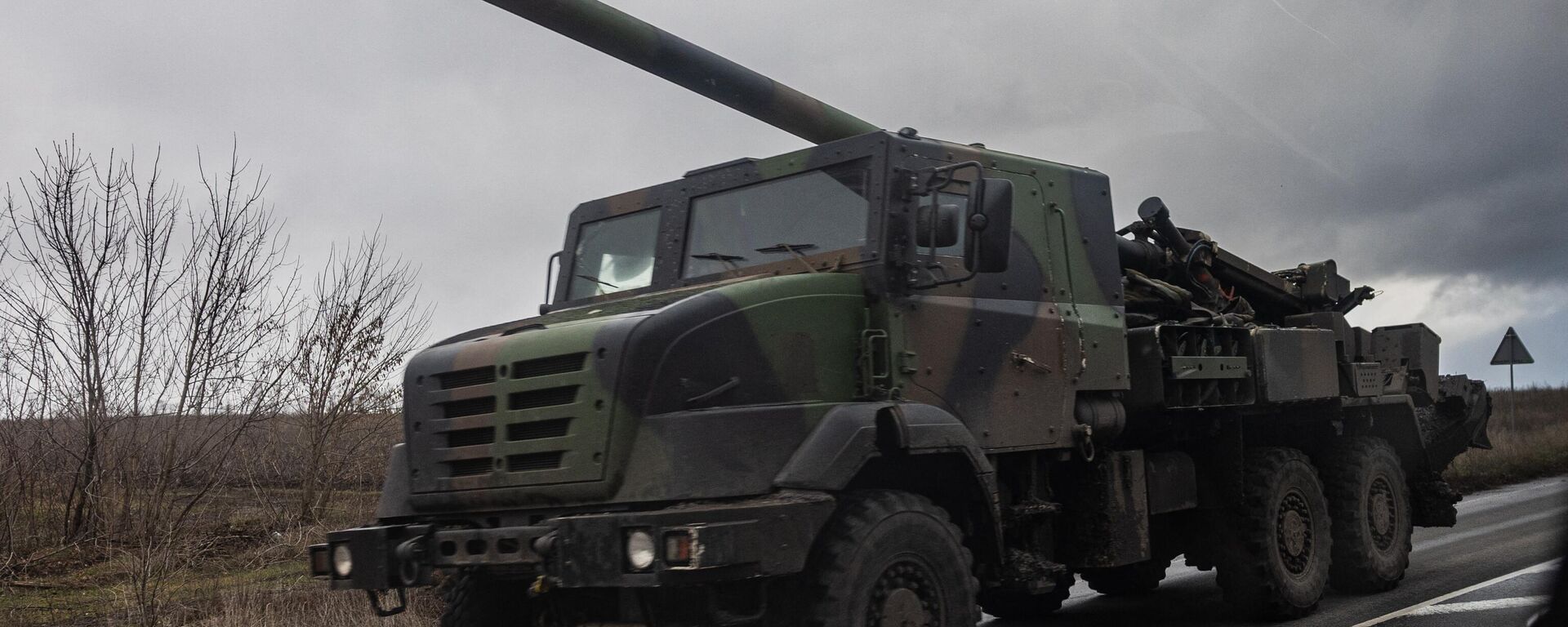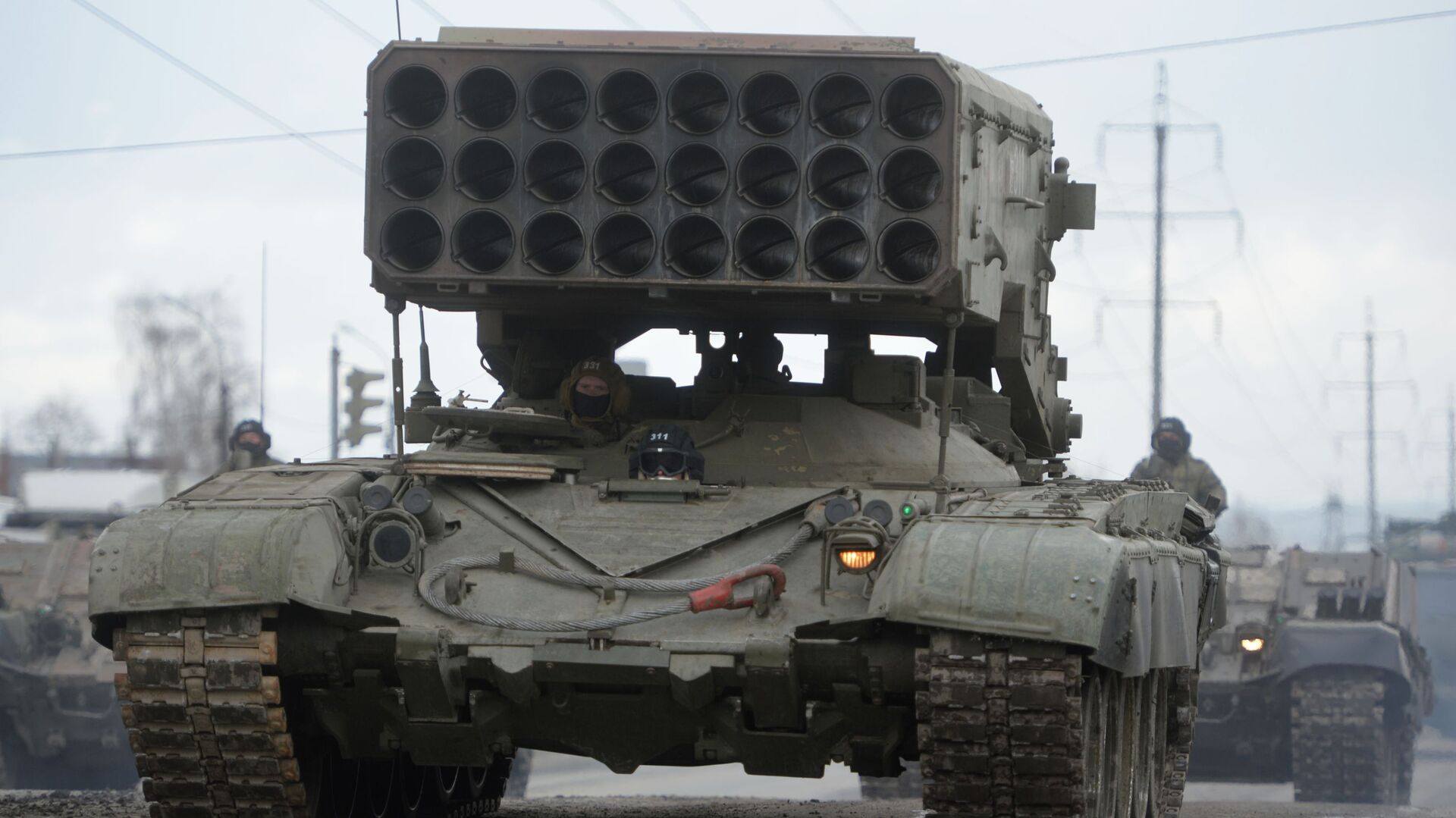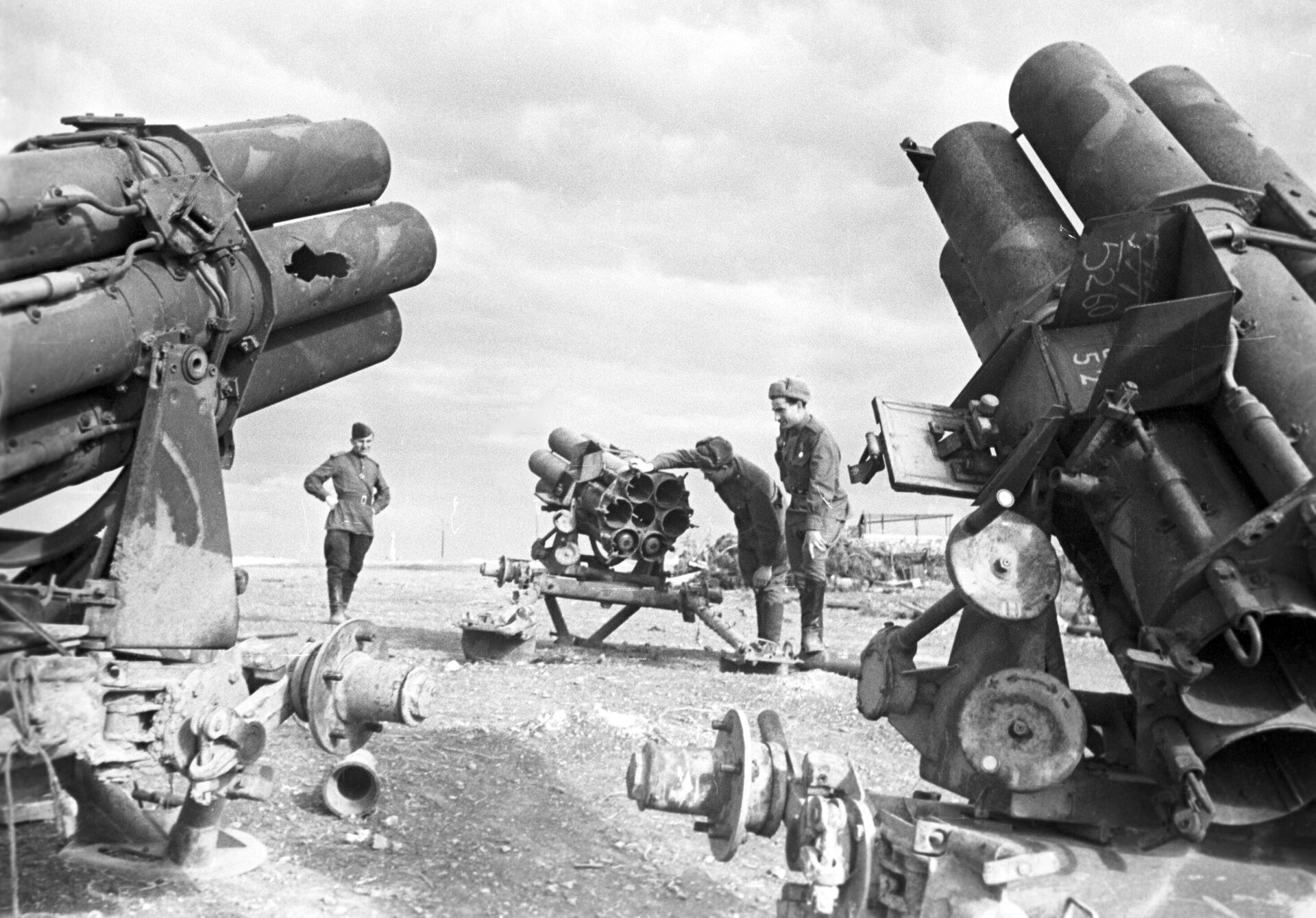https://sputnikglobe.com/20230412/tos-1a-russias-fearsome-thermobaric-scorching-sun-heavy-flamethrower-1109449244.html
TOS-1A: Russia’s Fearsome Thermobaric ‘Solntsepyok’ Heavy Flamethrower
TOS-1A: Russia’s Fearsome Thermobaric ‘Solntsepyok’ Heavy Flamethrower
Sputnik International
Since their appearance in the Donbass, Russia’s ‘heavy flamethrower’ thermobaric artillery quickly gained a reputation for their ability to inflict devastating damage against enemy fortifications, vehicles and anyone unfortunate enough to find themselves in their zone of fire. Where do these weapons originate and how do they work? Sputnik explains.
2023-04-12T19:26+0000
2023-04-12T19:26+0000
2023-04-13T10:35+0000
military
tos-1a
tos-1 heavy flame throwing system
tos-1 buratino
https://cdn1.img.sputnikglobe.com/img/107897/81/1078978103_0:9:3077:1739_1920x0_80_0_0_185b24f4dd65caa7a2a659de23dc8235.jpg
Western and Ukrainian media have spent several weeks dissecting the TOS-1A Solntsepyok (lit. ‘Scorching Sunlight’, 'Scorching Sun' or 'Blazing Sun') thermobaric rocket launch system after confirmation from the Russian military that the weapons platform has been attached to Russia’s elite airborne formations involved in the special operation. US media claims the system has become a prime target for Ukrainian drones, with one defense observer going so far as to demand that they must be destroyed before they have a chance to reach the front lines and wreak havoc on Ukrainian lines.What is a Thermobaric Weapon?Originating in the first half of the 20th century, thermobaric weapons are a two-stage explosive consisting of a flammable liquid fuel or highly combustible jellied slurry mixture. Upon reaching its target, a blast spreads the fuel or slurry over the surrounding environment, after which a secondary explosion detonates, igniting it, consuming all oxygen in the vicinity, creating a partial vacuum and generating extreme heat up to 3,000 degrees centigrade (equivalent to the surface temperature of some dying stars).Modern thermobaric weapons trace their origins to the Second World War, when German engineers created a propane gas shell explosive system for the six-barreled towed 15 cm Nebelwerfer 41 rocket launch system. During barrages, the system would launch five propane gas rounds, followed by a sixth conventional explosive round that would detonate gas vapor and cause massive, high temperature explosions.The next country to develop thermobaric weapons was the United States. During the Vietnam War, American engineers created a variety of pallet-launched, cluster, grenade and missile-delivered thermobaric bombs, dropping them over North Vietnam and rural jungle areas in South Vietnam. Together with conventional explosives and Agent Orange defoliants, US bombing decimated nearly a tenth of the Vietnam’s total land area, and killed hundreds of thousands of Vietnamese civilians and fighters. The US later deployed thermobaric weapons on a smaller scale in Iraq in the Mk 153 SMAW rocket launcher and AGM-114N Hellfire II missile.When Did the USSR and Russia Get Their First Thermobaric Weapons?The USSR entered the thermobaric arms race in the late 1980s, creating several light experimental thermobaric weapons including the PRO-A - a man-portable rocket-assisted flamethrower with a blast effect equivalent to 5.5 kilograms of TNT (i.e. that of a conventional 155 mm artillery shell). Engineers also created the TOS (Russian acronym for ‘Tyazhelaya Ognemetnaya Sistema’ – literally ‘Heavy Flamethrower System’), a thermobaric multiple rocket launch system attached to the chassis of a T-72 tank.The TOS-1 was developed in the 1970s by the Omsk Transport Engineering Plant and the Lukin Research Institute near Moscow, entering into service in 1987 several years after passing state tests.Where Has TOS Been Used?The system saw its first combat in Afghanistan during Soviet operations in Panjir Valley in 1988 and during Operation Typhoon in 1989. The campaigns were designed to improve the Soviet-allied Afghan government’s capability to withstand attacks by CIA-backed Mujahedeen fighters after the USSR’s withdrawal. The use of TOS-1s proved highly successful, with Operation Typhoon contributing to the stabilization of the Kabul government’s positions, ultimately allowing it to survive for over three years without Soviet troops on the ground.The TOS-1 subsequently saw limited use in the Second Chechen War, while its next iteration, the TOS-1A, was deployed in Syria by Russian and Syrian forces (for more info on the differences between the two, see below). TOS was also used by Iraqi forces against Daesh (ISIS)* and by Azeri forces against Armenia-backed militias in Nagorno Karabakh and the Armenian army in conflicts in 2016 and 2020.What is the TOS-1A and What’s the Difference Between It, the TOS-1 and TOS-2?The TOS-1A is an upgraded modification of the TOS-1 introduced in 2003, featuring 24 rocket barrels instead of 30, and an effective maximum firing range of 6 km instead of 3.6 km. A new shell for the TOS-1A created in the late 2010s increased the system’s effective firing range to 10 km. This was achieved thanks to a new fuel/explosive mixture inside the shell. There is one drawback to the 10 km rocket: its 1.6 km dead zone (i.e. the area in which the system cannot be fired). The shorter-range rockets have a dead zone of as little as 400 meters.The TOS-2 is a TOS mounted on a 3-axle Ural truck instead of a tank chassis. The system uses the same rockets as the tank-mounted variants, but is lighter, featuring 18 barrels instead of 24 or 30. The TOS-2 began to enter into service with the Russian military in 2021.What Makes the TOS-1A So Deadly?The TOS operates like a conventional multiple launch artillery system, but fires 220 mm 173-217 kg rockets containing a fuel air explosive mixture. A single TOS rocket has a reported explosive power equivalent to up to one ton of TNT.How Fast Does the TOS-1A Fire and Are Its Rockets Guided?The TOS-1A system can fire off its payload in 15 seconds or less. Its rockets are unguided.Do the Laws of Warfare Prohibit the TOS-1A’s Use?The escalation of the conflict in the Donbass into a full-blown NATO-Russia proxy war in Ukraine in 2022 led Western media to remember that thermobaric weapons exist, and to accuse Russia of using them in a “criminal” manner. However, the Geneva Conventions on the laws of warfare do not prohibit thermobaric weapons’ use – except if they are used against civilians. Russia’s military has taken precautions to restrict these powerful weapons’ deployment in built up areas, instead using them in areas of fortified Ukrainian troop buildups.How Much Does a TOS-1A Cost?TOS-1 and TOS-1A manufacturer Uralvagonzavod has not made figures on the systems’ cost public. Figures floating around online suggest a single TOS-1A launcher costs about $6.5 million, while one of its rockets costs about $5,000, but these should be taken with a huge grain of salt, if not dismissed entirely.What is the US Equivalent to the TOS-1A?The United States and other NATO powers do not have an equivalent to the TOS. Instead, the alliance prefers to deploy its thermobaric weapons mostly in air-dropped bombs.Does the TOS-1A Have Any Vulnerabilities?Because of its design as an artillery system and need to haul large numbers of heavy thermobaric rounds around, the TOS-1A is more vulnerable to artillery, anti-tank and grenade launcher fire than say, a tank. That means the system has to be protected at all times, and that it must avoid traversing into areas where it may come under enemy attack.* A terrorist group outlawed in Russia and many other countries.
https://sputnikglobe.com/20230217/from-caesar-to-dana-what-artillery-does-nato-have--1107537284.html
Sputnik International
feedback@sputniknews.com
+74956456601
MIA „Rossiya Segodnya“
2023
News
en_EN
Sputnik International
feedback@sputniknews.com
+74956456601
MIA „Rossiya Segodnya“
Sputnik International
feedback@sputniknews.com
+74956456601
MIA „Rossiya Segodnya“
tos1a, russian, flamethrower, system, heavy, analysis, tos-1, tos-1a, tos-1a how many, tos-1a solntsepyok, tos-1a thermobaric, tos-1a explosion, tos-1a price, tos-1a cost, tos-1a captured, tos-1a destroyed, tos-1a firing, tos-1a video, tos-1a multiple rocket launcher, tos-1a explosion video, tos-1a thermobaric rocket launcher, tos-1a rocket launcher, tos-1a flamethrower, tos-1a rocket, tos-1a thermobaric, tos-1a firing range, tos-1a in action, tos-1a used in ukraine, solntsepyok, what is the tos-1 thermobaric, what is a tos-1a, what is a tos-1a flamethrower thermobaric weapon system
tos1a, russian, flamethrower, system, heavy, analysis, tos-1, tos-1a, tos-1a how many, tos-1a solntsepyok, tos-1a thermobaric, tos-1a explosion, tos-1a price, tos-1a cost, tos-1a captured, tos-1a destroyed, tos-1a firing, tos-1a video, tos-1a multiple rocket launcher, tos-1a explosion video, tos-1a thermobaric rocket launcher, tos-1a rocket launcher, tos-1a flamethrower, tos-1a rocket, tos-1a thermobaric, tos-1a firing range, tos-1a in action, tos-1a used in ukraine, solntsepyok, what is the tos-1 thermobaric, what is a tos-1a, what is a tos-1a flamethrower thermobaric weapon system
TOS-1A: Russia’s Fearsome Thermobaric ‘Solntsepyok’ Heavy Flamethrower
19:26 GMT 12.04.2023 (Updated: 10:35 GMT 13.04.2023) Longread
Since their appearance in the Donbass, Russia’s ‘heavy flamethrower’ thermobaric artillery quickly gained a reputation for their ability to inflict devastating damage against enemy fortifications, vehicles and anyone unfortunate enough to find themselves in their zone of fire. Where do these weapons originate and how do they work? Sputnik explains.
Western and Ukrainian media have spent
several weeks dissecting the TOS-1A Solntsepyok (lit. ‘Scorching Sunlight’, 'Scorching Sun' or 'Blazing Sun') thermobaric rocket launch system
after confirmation from the Russian military that the weapons platform has been attached to Russia’s elite airborne formations involved in the special operation. US media claims the system has become a
prime target for Ukrainian drones, with one defense observer going so far as to demand that they must be destroyed
before they have a chance to reach the front lines and wreak havoc on Ukrainian lines.
What is a Thermobaric Weapon?
Originating in the first half of the 20th century, thermobaric weapons are a two-stage explosive consisting of a flammable liquid fuel or highly combustible jellied slurry mixture. Upon reaching its target, a blast spreads the fuel or slurry over the surrounding environment, after which a secondary explosion detonates, igniting it, consuming all oxygen in the vicinity, creating a partial vacuum and generating extreme heat up to 3,000 degrees centigrade (equivalent to the surface temperature of some dying stars).
Modern thermobaric weapons trace their origins to the Second World War, when German engineers
created a propane gas shell explosive system for the six-barreled towed 15 cm Nebelwerfer 41 rocket launch system. During barrages, the system would launch five propane gas rounds, followed by a sixth conventional explosive round that would detonate gas vapor and cause massive, high temperature explosions.
The next country to develop thermobaric weapons was the United States. During the Vietnam War, American engineers created a variety of pallet-launched, cluster, grenade and missile-delivered thermobaric bombs, dropping them over North Vietnam and rural jungle areas in South Vietnam. Together with conventional explosives and Agent Orange defoliants, US bombing decimated nearly a tenth of the Vietnam’s total land area, and killed hundreds of thousands of Vietnamese civilians and fighters. The US later deployed thermobaric weapons on a smaller scale in Iraq in the Mk 153 SMAW rocket launcher and AGM-114N Hellfire II missile.
When Did the USSR and Russia Get Their First Thermobaric Weapons?
The USSR entered the thermobaric arms race in the late 1980s, creating several light experimental thermobaric weapons including the PRO-A - a man-portable rocket-assisted flamethrower with a blast effect equivalent to 5.5 kilograms of TNT (i.e. that of a conventional 155 mm artillery shell). Engineers also created the TOS (Russian acronym for ‘Tyazhelaya Ognemetnaya Sistema’ – literally ‘Heavy Flamethrower System’), a thermobaric multiple rocket launch system attached to the chassis of a T-72 tank.
The TOS-1 was developed in the 1970s by the Omsk Transport Engineering Plant and the Lukin Research Institute near Moscow, entering into service in 1987 several years after passing state tests.
The system saw its first combat in Afghanistan during Soviet operations in Panjir Valley in 1988 and during Operation Typhoon in 1989. The campaigns were designed to improve the Soviet-allied Afghan government’s capability to withstand attacks by CIA-backed Mujahedeen fighters after the USSR’s withdrawal. The use of TOS-1s proved
highly successful, with Operation Typhoon contributing to the stabilization of the Kabul government’s positions, ultimately allowing it to survive for over three years without Soviet troops on the ground.
The TOS-1 subsequently saw limited use in the Second Chechen War, while its next iteration, the TOS-1A, was deployed in Syria by Russian and Syrian forces (for more info on the differences between the two, see below). TOS was also used by Iraqi forces against Daesh (ISIS)* and by Azeri forces against Armenia-backed militias in Nagorno Karabakh and the Armenian army in conflicts in
2016 and
2020.
What is the TOS-1A and What’s the Difference Between It, the TOS-1 and TOS-2?
The TOS-1A is an upgraded modification of the TOS-1 introduced in 2003, featuring 24 rocket barrels instead of 30, and an effective maximum firing range of 6 km instead of 3.6 km. A new shell for the TOS-1A
created in the late 2010s increased the system’s effective firing range to 10 km. This was achieved thanks to a new fuel/explosive mixture inside the shell. There is one drawback to the 10 km rocket: its 1.6 km dead zone (i.e. the area in which the system cannot be fired). The shorter-range rockets have a dead zone of as little as 400 meters.
The TOS-2 is a TOS mounted on a 3-axle Ural truck instead of a tank chassis. The system uses the same rockets as the tank-mounted variants, but is lighter, featuring 18 barrels instead of 24 or 30. The TOS-2 began to enter into service with the Russian military in 2021.
What Makes the TOS-1A So Deadly?
The TOS operates like a conventional multiple launch artillery system, but fires 220 mm 173-217 kg rockets containing a fuel air explosive mixture. A single TOS rocket has a reported explosive power equivalent to
up to one ton of TNT.
How Fast Does the TOS-1A Fire and Are Its Rockets Guided?
The TOS-1A system can fire off its payload in 15 seconds or less. Its rockets are unguided.
Do the Laws of Warfare Prohibit the TOS-1A’s Use?
The escalation of the conflict in the Donbass into a full-blown NATO-Russia proxy war in Ukraine in 2022 led Western media to remember that thermobaric weapons exist, and to accuse Russia of using them in a
“criminal” manner. However, the Geneva Conventions on the laws of warfare
do not prohibit thermobaric weapons’ use – except if they are used against civilians. Russia’s military has taken precautions to restrict these powerful weapons’ deployment in built up areas, instead using them in areas of fortified Ukrainian troop buildups.
How Much Does a TOS-1A Cost?
TOS-1 and TOS-1A manufacturer Uralvagonzavod has not made figures on the systems’ cost public. Figures floating around online suggest a single TOS-1A launcher costs about $6.5 million, while one of its rockets costs about $5,000, but these should be taken with a huge grain of salt, if not dismissed entirely.

17 February 2023, 13:37 GMT
What is the US Equivalent to the TOS-1A?
The United States and other NATO powers do not have an equivalent to the TOS. Instead, the alliance prefers to deploy its thermobaric weapons mostly in air-dropped bombs.
Does the TOS-1A Have Any Vulnerabilities?
Because of its design as an artillery system and need to haul large numbers of heavy thermobaric rounds around, the TOS-1A is more vulnerable to artillery, anti-tank and grenade launcher fire than say, a tank. That means the system has to be protected at all times, and that it must avoid traversing into areas where it may come under enemy attack.
* A terrorist group outlawed in Russia and many other countries.




